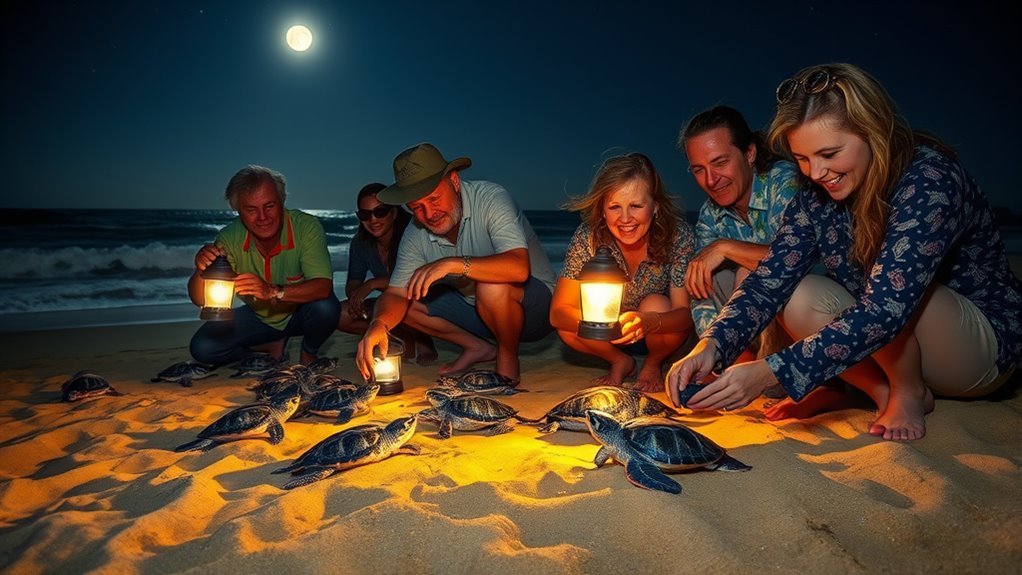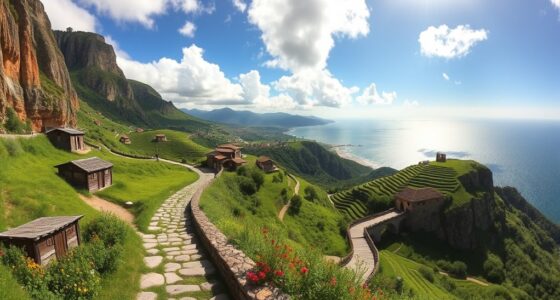In Nicaragua, community-run turtle conservation relies on local people actively protecting nesting sites, promoting sustainable tourism, and educating visitors about turtle importance. These efforts create economic incentives and foster pride, encouraging long-term commitment. Challenges like policy hurdles and funding shortages exist but community-led initiatives, including patrols and traditional knowledge, have successfully improved turtle populations. Keep exploring to discover how these grassroots actions are making a real difference for future generations.
Key Takeaways
- Local communities actively participate in monitoring nesting sites and enforcing protection measures.
- Community-led patrols and education programs increase awareness and reduce poaching.
- Ecotourism initiatives provide economic incentives, encouraging sustainable conservation efforts.
- Traditional knowledge and customs are integrated into conservation strategies to strengthen community commitment.
- Challenges such as limited funding and policy restrictions are addressed through local stakeholder collaboration.
The Role of Local Communities in Turtle Conservation
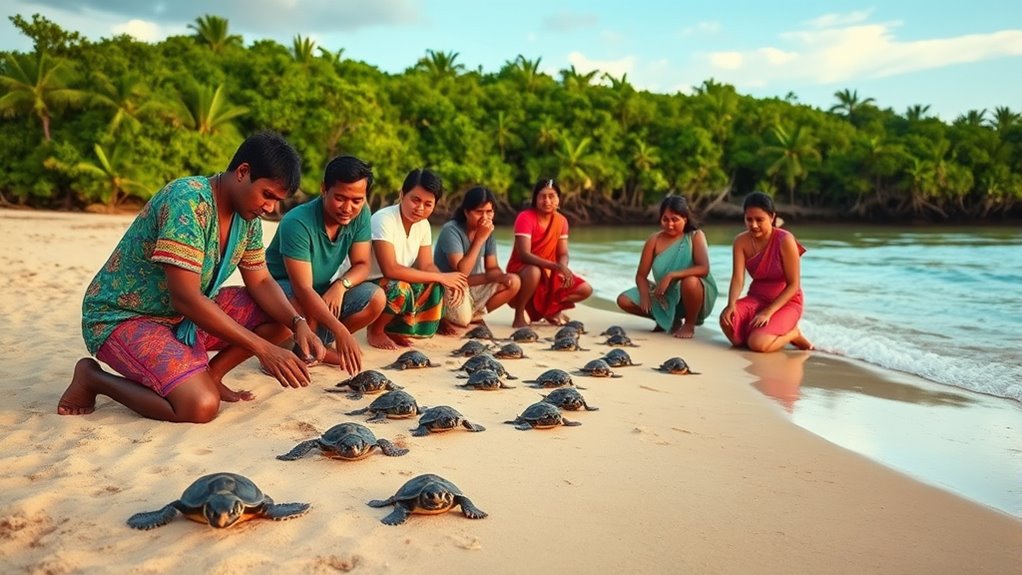
Local communities play a crucial role in turtle conservation because their active participation directly impacts the success of protection efforts. You can leverage cultural traditions that honor marine life to foster a sense of pride and responsibility. Engaging in education programs helps raise awareness about the importance of turtles and the threats they face. When community members understand the ecological and cultural significance of these creatures, they’re more likely to participate in conservation activities. Your involvement can include monitoring nesting sites, reducing harmful practices, and promoting sustainable tourism. By integrating local customs into conservation initiatives, you strengthen community ties and ensure long-term commitment. Ultimately, your participation transforms conservation from an external effort into a shared community goal, increasing the chances of protecting Nicaragua’s turtle populations.
Successful Strategies and Initiatives in Nicaragua

Several successful strategies have propelled turtle conservation efforts in Nicaragua, combining community engagement, scientific research, and sustainable practices. Establishing marine protected areas has been key, safeguarding critical nesting beaches and foraging habitats from exploitation. These protected zones help maintain healthy turtle populations and encourage eco-friendly activities. Additionally, ecotourism development offers economic incentives for local communities, motivating them to protect turtles instead of exploiting them. Visitors attracted to turtle nesting sites generate income while raising awareness about conservation needs. Community-led patrols, education programs, and sustainable fishing practices further reinforce these initiatives. Promoting community participation is essential to ensure the long-term success of these efforts. By integrating these strategies, Nicaragua creates a resilient framework that supports turtle survival and benefits local livelihoods, demonstrating how conservation and development goals can align effectively through extensive, community-driven efforts.
Challenges Faced by Grassroots Conservation Efforts

Despite the passion and dedication of community members, grassroots conservation efforts in Nicaragua face significant challenges that threaten their success. Policy obstacles often hinder local initiatives, with government regulations sometimes limiting access to protected areas or restricting community-led activities. These policies can create confusion or delays, making it harder for groups to implement effective strategies. Funding limitations also pose a major hurdle, as communities rely heavily on scarce resources and donations to sustain their work. Without consistent financial support, maintaining patrols, monitoring nests, and educating the public becomes difficult. These challenges can frustrate volunteers and undermine long-term progress. Understanding Gold IRA investment options and the importance of securing reliable funding are vital steps to strengthen grassroots efforts and guarantee the survival of turtle populations in Nicaragua.
The Impact of Community Engagement on Turtle Populations
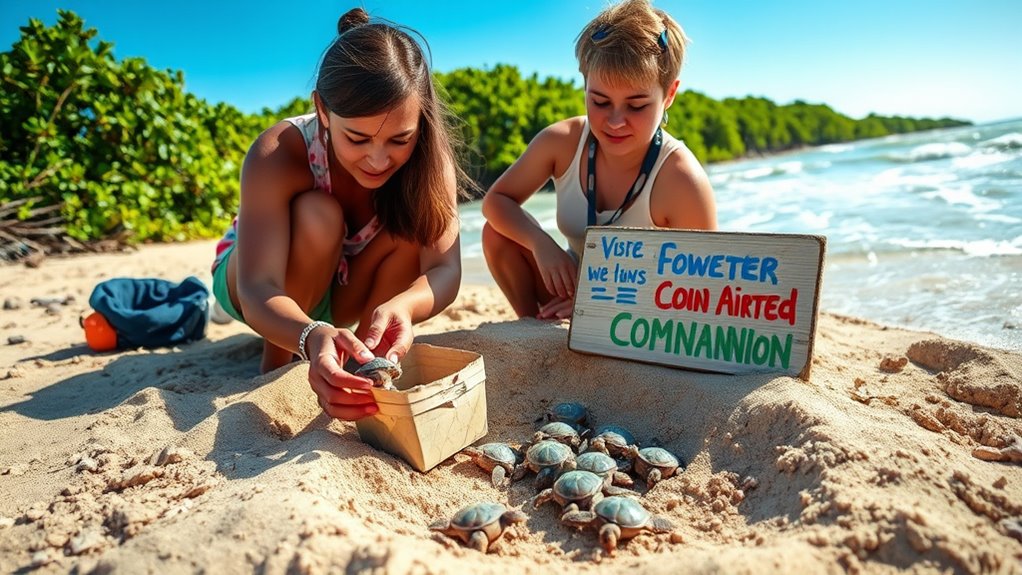
Community engagement plays a essential role in protecting and restoring turtle populations in Nicaragua. When you get involved, you help local conservation efforts succeed by applying marine biology knowledge to real-world challenges. Your participation raises awareness about the importance of turtles and their habitats, inspiring others to take action. Through ecotourism, you create economic incentives for communities to preserve nesting sites and reduce harmful activities, like poaching. This active involvement fosters a sense of ownership and responsibility, leading to more consistent conservation practices. As a result, turtle populations begin to recover, with increased hatchling success and healthier adult populations. Your commitment not only benefits the turtles but also strengthens community ties and promotes sustainable development, making conservation efforts more effective and lasting.
Building Sustainable Practices for Future Conservation
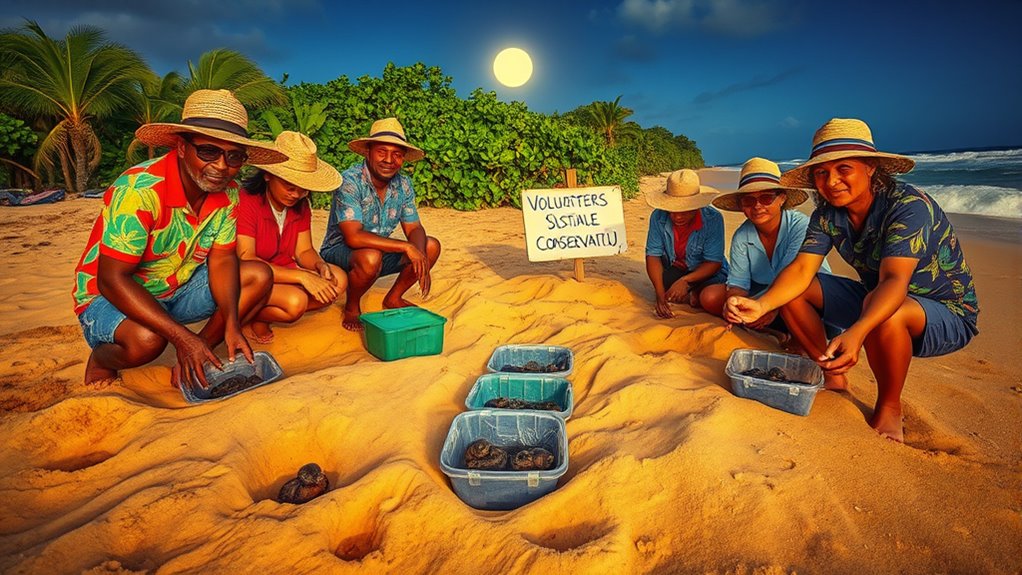
Building sustainable practices for future conservation guarantees that the progress made in protecting turtles continues long-term. You can achieve this by promoting eco tourism development that benefits local communities while raising awareness about turtle preservation. Integrating traditional knowledge from community elders helps preserve cultural heritage and enhances conservation strategies. Empowering locals to participate in decision-making fosters ownership and responsibility. Supporting sustainable practices ensures that future generations inherit a healthy ecosystem. Implementing targeted email marketing campaigns can effectively raise awareness and mobilize community involvement in conservation efforts.
- Witnessing eco tourism create livelihoods while safeguarding turtles
- Preserving ancient wisdom that guides effective conservation
- Strengthening community bonds through shared goals
- Creating a legacy of environmental stewardship
- Inspiring others to adopt sustainable, community-led solutions
Frequently Asked Questions
How Do Community Members Benefit Economically From Turtle Conservation?
You benefit economically from turtle conservation through eco tourism opportunities that attract visitors and generate income. By practicing sustainable fishing methods, you help protect turtle populations, ensuring long-term fish stocks. This balance supports local livelihoods and creates more jobs. Engaging in conservation also boosts community pride and attracts funding or grants. Overall, your efforts lead to a healthier environment and a more resilient local economy, making conservation a smart, sustainable choice.
What Training Do Locals Receive to Participate in Conservation Efforts?
You’ll be amazed at how much you can learn through training in habitat restoration and wildlife monitoring—it’s like opening a secret world! Locals receive hands-on instruction in protecting nesting sites, tracking turtle populations, and restoring habitats. This knowledge empowers you to actively contribute to conservation, ensuring these incredible creatures thrive. With this training, you become an essential part of the effort to save turtles and preserve Nicaragua’s rich biodiversity.
How Is Turtle Population Health Monitored in Community-Led Projects?
You conduct turtle population health monitoring through regular turtle nesting surveys, where you record nesting sites and hatchling counts. You also use health assessment techniques, like checking for injuries or signs of disease, to guarantee the turtles are healthy. By consistently collecting data and observing nesting patterns, you help track population trends, identify threats, and support conservation efforts to protect these essential species.
Are There Any Legal Protections Supporting Grassroots Conservation Initiatives?
You should know that legal frameworks and policy support are essential for grassroots conservation efforts. They provide formal recognition and protection, empowering local communities to take action. These laws often include regulations that safeguard endangered species and encourage community participation. By aligning local initiatives with national policies, you guarantee better resource access, legal backing, and long-term sustainability for your conservation projects, ultimately boosting their effectiveness and community engagement.
How Do Cultural Attitudes Influence Community Participation in Turtle Conservation?
You see, cultural beliefs and traditional practices deeply shape how communities engage in conservation efforts. When local customs value protecting turtles, participation naturally increases; people feel a sense of responsibility and pride. Conversely, if traditional practices conflict with conservation goals, participation may decline. Understanding these cultural attitudes helps you design initiatives that respect local values, encouraging community involvement and ensuring sustainable conservation practices that resonate culturally.
Conclusion
By actively participating in community-led efforts, you become a guardian of Nicaragua’s turtles, turning back the tide of decline like a modern-day Noah. Your dedication helps restore populations and preserves this natural treasure for future generations. Keep embracing sustainable practices, rallying others like a grassroots revolution, and remember, your actions today echo through time—much like the timeless stories etched in ancient cave paintings—ensuring these magnificent creatures thrive long after our time.

